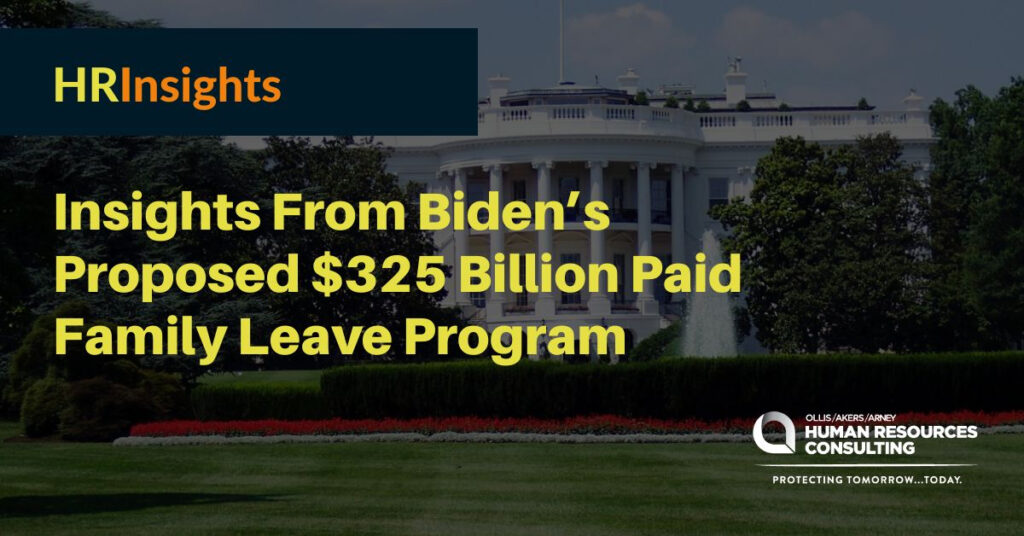Today in the United States, workers are not guaranteed paid leave by federal law, and many aren’t entitled to unpaid time. To address this issue, President Joe Biden released a budget plan earlier this year, allocating $325 billion to a permanent paid family and medical leave program.
The Family and Medical Leave Act (FMLA) is a federal law enacted 30 years ago to allow eligible employees of covered employers to take unpaid, job-protected leave for certain family and medical reasons. Still, the country does not yet have some form of universal paid family and medical leave. While the presidential budget is a promising step in the right direction for paid leave advocates, the program faces many hurdles. Regardless, employers can find important paid leave takeaways from this program.
This article explores Biden’s proposed paid leave program and market trends related to leave policies. It also discusses employer considerations the program engenders.
Biden’s Proposed Program
The United States lacks universal paid leave for workers. In fact, the United States is the only country without a paid parental leave policy among nations in an organization of the largest economies called the Organisation for Economic Co-operation and Development. Without the guarantee of paid leave, many Americans are faced with choosing between work and their personal or family health care needs.
As part of the Biden administration’s $6.8 trillion budget plan for the fiscal year 2024, there is a $325 billion commitment to a comprehensive, permanent paid family and medical leave program. The proposed program would ensure workers access to paid leave to:
Bond with a new child
Care for a seriously ill loved one
Deal with a loved one’s military deployment Heal from their own serious illness
Grieve the death of a loved one
Seek safety and recover from domestic violence, dating violence, sexual assault or stalking
Regardless of the final budget resolution, more employers may be subject to paid leave laws in their states or may be exploring ways to offer their own paid leave policies.
In general, this proposed program may push employers to better understand the difference between the FMLA and related paid leave. The COVID-19 pandemic illustrated the importance of paid family and medical leave, and more workers may be looking for opportunities to work for an organization that offers some type of paid leave.
Market Trends
The U.S. Bureau of Labor Statistics found that more than 3 in 4 employees (76%) in the private sector do not have paid family leave. Furthermore, about 90 million (56%) U.S. workers have care responsibilities outside of their full-time jobs, according to the Council of Economic Advisers. As such, paid leave policies would not only be an attractive and competitive benefit to today’s workers, but they could be a lifeline for these workers as they balance personal and professional duties.
Some states and localities are expanding access to paid family and medical leave and are prioritizing and adopting paid leave laws, providing benefits to workers for medical, caregiving and parental leaves. To date, 11 states and counting offer paid family and medical leave.
In general, all signs point to industry leaders and workers wanting more paid leave to attend to the family and medical needs of themselves and their loved ones.
Employer Considerations
As more states and localities pass paid leave laws and the Biden administration proposes the paid leave program, employers may assess and update their leave policies to better support their workers.
To do this, employers must ensure their leave policies are current and comply with local laws. It’s critical to review existing policies to confirm they conform to state and local regulations of the location where employees physically work. Additionally, an employer’s leave policies can clearly explain when employees are eligible for paid leave and outline the steps they must follow to request it. Employers should verify that their leave policies do not unintentionally discriminate against employees based on a protected class.
Summary
Leave policies are important to today’s workers as they try to balance working and taking care of the family and medical needs of themselves and their loved ones. Employers should continue to monitor legislative developments and workers’ desires while ensuring their leave policies are current and reflect the most recent regulatory developments.
Contact Ollis/Akers/Arney Human Resources Consulting for more information about paid leave benefits.
This HR Insights is not intended to be exhaustive nor should any discussion or opinions be construed as professional advice. © 2023 Zywave, Inc. All rights reserved.






